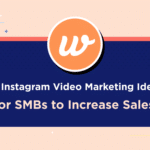
A finance video isn’t just another marketing asset. It’s a powerful way for financial professionals to cut through the noise, make complex ideas simple, and, most importantly, build deep, lasting client trust. By turning dense data and confusing market jargon into engaging visual stories, these videos make things like investment strategies, insurance options, and market outlooks understandable for everyone. It’s a genuine way to show transparency and expertise in an industry that’s built entirely on relationships.
Why Finance Videos Build Unbeatable Client Trust
In finance, trust isn’t a “nice to have”: it’s the bedrock of every single client relationship. For years, financial communication has relied on thick reports, complicated spreadsheets, and conversations heavy with technical terms. While that information is necessary, let’s be honest: it often puts up a wall, leaving clients feeling intimidated or disconnected from their own financial future.
A well-crafted finance video demolishes that wall.
Putting a face to the name and speaking directly to your audience creates a human connection that text just can’t match. It allows you to convey empathy, confidence, and transparency through your tone of voice and expressions. This personal element is absolutely critical when discussing sensitive topics like retirement planning or wealth management. Suddenly, an abstract financial plan becomes a clear, achievable path guided by an expert they can see and hear.
Making Complex Ideas Simple with Visuals
One of the greatest strengths of video is its ability to make complicated information easy to digest. Instead of trying to describe a market trend with a wall of text, a video can show it with an animated chart that moves and breathes. This kind of visual storytelling helps clients grasp tough concepts faster and retain them longer.
Just think about these real-world situations:
- Explaining a New Fund: An animated video can break down the fund’s goals, strategy, and risk level using simple graphics and a clear voiceover.
- Onboarding a New Client: A short, welcoming video can walk them through what to expect, introduce them to your team, and share your firm’s philosophy.
- Quarterly Market Outlook: You can record a quick analysis, pointing to key charts and data points on-screen to explain recent performance and what you’re planning next.
The goal is to stop telling clients about their finances and start showing them. This simple shift empowers them with genuine understanding and solidifies their confidence in your guidance.
This isn’t just a hunch; the data backs it up. The use of video in business is exploding. In fact, an overwhelming 89% of businesses now count video as part of their marketing strategy. This isn’t just for show, 93% of marketers report a positive return on their video investment.
To get started, it’s worth taking a look at the tangible benefits video brings to a financial practice.
Core Benefits of Video for Financial Practices
Here’s a quick look at the tangible advantages you can expect when adding video to your client communication toolkit.
| Benefit | Impact on Your Practice |
|---|---|
| Increased Trust | Clients see and hear from you directly, building a stronger, more personal connection than text-based communication ever could. |
| Improved Comprehension | Visuals and animation make complex financial concepts easier for clients to grasp, leading to more informed and confident decisions. |
| Enhanced Engagement | Videos are more captivating than reports or emails, leading to higher open rates and more time spent with your content. |
| Time Savings | A single explainer video can answer common questions for hundreds of clients, freeing up your time for more personalized advice. |
| Greater Accessibility | Video makes your expertise accessible to a wider audience, including those who prefer visual learning or are new to investing. |
The bottom line is that video helps you communicate more effectively, build stronger relationships, and ultimately, grow your practice.
Fortunately, technology has solved this challenge for finance professionals. Modern tools like Wideo have completely changed the game, offering solutions for video automation for the finance industry. You can create polished, on-brand finance videos right in your own office, making sure your message is both clear and completely authentic.
Matching Your Video to Your Client’s Needs
Starting a finance video from a blank screen can feel a lot like staring at an empty spreadsheet. It’s intimidating, and it’s easy to feel uninspired. There’s a much better way to go about it: start with a solid foundation.
Picking the right video template isn’t just about finding a design that looks nice. It’s about matching the video’s structure to what you’re trying to communicate to your client. You wouldn’t use a hammer to turn a screw, right? In the same way, a template for a quarterly market report should look and feel completely different from one that welcomes a new client.
Aligning Templates with Your Purpose
First things first, you need to be crystal clear on what you want the video to achieve. Are you educating? Reassuring? Celebrating a milestone? Each of these goals requires a totally different visual style and narrative approach.
Let’s say you’re explaining a new investment fund. Clarity is everything. You’ll want to look for templates with strong data visualization features, like animated bar graphs or pie charts that make complex metrics simple to grasp. The tone should be confident and packed with information.
Now, flip the script. An onboarding video is all about building a relationship. For that, you’ll want templates with a warmer, more approachable vibe. Think friendly character animations or layouts that put a welcome message and team photos front and center. The whole point is to make a new client feel seen and valued from their very first interaction.
Customizing for Brand Consistency
Once you’ve landed on a template that fits your goal, the real magic happens. This is where you take a generic layout and make it unmistakably yours. A consistent brand identity doesn’t just look professional; it helps clients instantly recognize your communications and builds trust.
Here are a few key elements you absolutely have to customize:
- Your Logo: This one’s non-negotiable. Make sure your firm’s logo is easy to spot, usually in a corner of the screen or on the intro and outro slides.
- Brand Colors: Ditch the template’s default colors and swap in your own brand palette. A consistent color scheme across all your materials is the bedrock of a strong, cohesive identity.
- Typography: Pick fonts that match your brand’s personality. A traditional serif font might communicate stability and heritage, while a clean sans-serif font can feel more modern and direct.
When you thoughtfully choose and customize your template, you’re doing more than just sending a video. You’re delivering a clear message that also strengthens your brand. That attention to detail shows clients you care about every part of their experience, building a little more trust with every single view.
Transforming Complex Finance Into Compelling Stories

While a great template gives you the visual framework for your finance video, it’s your message that truly connects with clients. This is where you go beyond the numbers and charts to tell a story that informs, persuades, and, most importantly, reassures your audience.
The best financial stories are all built on one core principle: clarity over complexity. Your clients don’t need you to sound like a Wall Street analyst; they need you to be their trusted guide. That means swapping out financial jargon for plain language that actually connects with their day-to-day lives.
For instance, instead of saying “portfolio diversification mitigates unsystematic risk,” try a relatable analogy. You could say, “We don’t put all our eggs in one basket. By spreading your investments across different areas, we protect your money if one area has a temporary dip.” See the difference? That simple shift makes the concept instantly accessible.
Hook Your Audience in the First Five Seconds
You have just a few moments to grab your viewer’s attention before they swipe on to the next thing. Seriously, those first five seconds are your most valuable real estate. Don’t waste them with a slow-burn logo animation or a generic “hello.”
Jump right in with a compelling question, a surprising statistic, or a bold statement that hits on a client’s specific pain point or goal.
Here are a few ideas:
- For retirement planning: “Are you sure you’ll have enough to live comfortably for 30 years after you stop working?”
- For a market update: “Worried about the recent market swings? Here’s what it actually means for your portfolio.”
- For an insurance video: “What would happen to your family’s financial security if the unexpected happened tomorrow?”
A powerful hook grabs your viewer and promises them value. It tells them you understand their concerns and have answers, ensuring they stick around to hear what you have to say next.
Structure Your Narrative for Impact
Once you have their attention, your story needs a clear path: a beginning, a middle, and an end. A scattered message will only create confusion and chip away at the trust you’re trying to build.
A simple yet incredibly effective structure for any finance video is the Problem-Solution-Benefit framework.
- Problem: Start by identifying the specific challenge your client is up against (e.g., “Saving for a down payment feels impossible.”)
- Solution: Position your service or strategy as the clear answer to that problem (e.g., “Our automated savings plan makes it effortless.”)
- Benefit: Finish by painting a picture of the positive outcome they’ll achieve (e.g., “So you can get the keys to your new home, faster.”)
This narrative approach transforms abstract financial concepts into a tangible journey with clear, achievable outcomes. Want to perfect this technique? check out our article on how to write an effective explainer video script for expert tips and strategies.
The most impactful financial stories aren’t about numbers; they’re about people. They’re about helping clients achieve their dreams, whether that’s retiring with dignity, sending their kids to college, or buying their first home.
Finally, every video must end with a clear and direct call-to-action (CTA). Don’t leave them hanging. Tell your viewers exactly what you want them to do next. Whether it’s “Schedule a call with us,” “Download our free guide,” or “Visit our website to learn more,” a strong CTA is what turns passive viewers into engaged clients.
From Good to Great: Polishing Your Financial Video Content

You’ve got a compelling story and a solid script. Now comes the part that separates the amateurs from the pros: the polish. This is where you layer in the small details that make a finance video feel credible, trustworthy, and truly professional. It’s about building a cohesive experience that reinforces your expertise from the first frame to the last.
It all boils down to your brand identity. Consistency isn’t just about looking good; it’s about building instant recognition and trust with your audience. Your logo, your specific brand colors, your chosen fonts, these are the signatures of your firm. When using a tool like Wideo, you can upload your logo and lock in your color palette right away, making sure every scene aligns perfectly with who you are.
Think about the psychology of color for a moment. It does more than just decorate the screen; it sets a mood. A palette of deep blues and grays can project stability and authority, which is perfect for a serious market analysis. On the other hand, softer, warmer tones can feel more reassuring and approachable, ideal for a retirement planning guide.
Unifying Your Visuals
Once your core brand elements are set, the name of the game is consistency. Every single element, from the text boxes to the animated charts, should feel like it belongs. This creates a seamless viewing experience that tells your audience you’re intentional and detail-oriented.
Here are a few practical ways to nail this:
- Logo Placement: Pick a corner and stick with it. Placing your logo in the same spot on every scene provides a subtle but constant reminder of your brand without being distracting.
- Font Choices: Stick to one or two fonts that reflect your firm’s personality. Above all, they must be clear and readable. When you’re explaining complex financial concepts, clarity is king.
- Color Application: Use your primary and secondary brand colors for text, icons, and graphic elements. It’s a simple action that visually ties the entire video together.
A cohesive brand presentation sends a powerful, unspoken message to your clients: you are professional, organized, and you care about the details. In the world of finance, those qualities mean everything.
Getting Your Video in Front of the Right People
Creating a brilliant finance video is a huge accomplishment, but it’s only half the journey. A powerful message is wasted if it never reaches the people who need to see it. Smart distribution is what turns your polished video from a file on your computer into a tool that actively works for your practice.
The secret is meeting your audience exactly where they already are, but delivering your message with fresh energy and engagement. There’s no need to build entirely new channels, simply integrate your compelling video content into the communication platforms your clients already trust and use daily.
Once your finance video is ready to go, integrating it into broader digital marketing strategies for local businesses is the next logical step. Your video can easily become the cornerstone of these efforts, making every touchpoint more impactful.
Making Video the Heart of Your Communication System
Start with your most valuable digital real estate: your website. Embedding your new video on relevant service pages can dramatically improve how well prospects understand what you do.
For example, why not place a video explaining your wealth management philosophy right on that service page? This gives potential clients an immediate, engaging overview of your approach before they even pick up the phone.
Email is another powerhouse channel just waiting for a video upgrade. Instead of sending a text-heavy newsletter about market updates or policy changes, lead with a concise video. An email with a video thumbnail is far more inviting. It also allows you to explain complex nuances with your own voice, which builds incredible confidence and can help reduce client anxiety.
Here are a few other high-impact ways to put your video to work:
- Client Onboarding: A personalized welcome video sent to a new client is a fantastic touch. It’s warm and personal, setting a positive tone from the very first day.
- Virtual Meetings: During a virtual review, use a short video to explain a complex chart or performance data. Visuals make dense information so much easier to digest.
- Social Media: Share quick clips on platforms like LinkedIn. This is a great way to engage prospective clients with quick financial tips or market insights.
Your Finance Video Creation Toolkit
Building your finance video creation toolkit doesn’t have to be complicated or expensive. With the right combination of platforms and basic equipment, you can produce professional-quality content that builds trust with your clients. Here’s what you actually need to get started.
Platforms like Wideo have really changed the game. They’re built specifically to help people like you produce high-quality animated videos using pre-made templates and your own branding. And for any live-action shots? Your smartphone is probably more than enough, especially when paired with a decent microphone and good lighting. It’s all you need to come across as polished and trustworthy.






